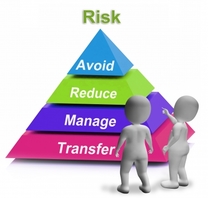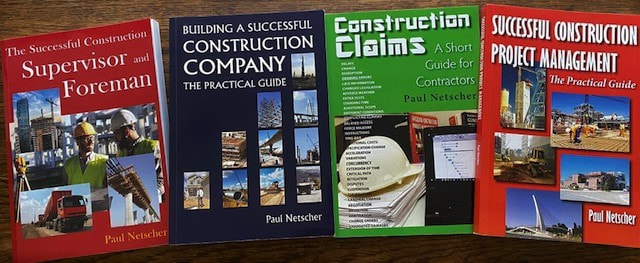"Construction is a risky business. Some projects are riskier than others. We need to understand the risks" Last week I published an article ‘Construction risk and the haunted house’. I mentioned that some contractors see risks everywhere, adding in contingencies for every possible event, while other contractors rush blindly into projects without seeing and allowing for risks that should easily have been foreseen. I recommended contractors fully understand the project and conditions pertaining to it while pricing it, then prepare a schedule of all the potential risks and grade them as to the likeliness of the event happening and also rate the risk’s potential impact. Not all projects are alike and simply adding a standard contingency to your project schedule and project price may make your project too expensive for your customer, or result in you losing money when things go wrong. In doing this we need to rely on our experience and understand how often a particular risk has eventuated. In this article we’ll look at the risk schedule in a little more detail and how we can deal with risks. How to deal with risks on construction projects"Decide the best way to deal with project risks" Once we have our risk schedule we can decide how we should deal with the risks. 1. We can ignore the risks if their impact is low or the likelihood of the event happening is low. I used the example of flying where there are catastrophic plane accidents every year and yet the risk of being involved in one is extremely small so we all still fly. Of course we are usually selective and choose airlines with a good safety record. We should do the same in construction and take sensible precautions. 2. We should check that the risk isn’t a normal risk which is already covered in our price. Some risks contractors are expected to allow for in the normal course of business. For instance our productivity rates used to price the project may already take into account certain interruptions. 3. Check that the risk is your problem. If the customer/client issues information late or grants access late is that your problem? Most contracts would specify that in these cases the contractor would be entitled to claim extension of time. Although, it’s not always as straight forward as this as a delay may impact the project in other ways – such as pushing the project into a period of unfavourable weather conditions, or causing you to be unable to use your resources as productively as expected. So while a risk may not be your problem it may just have other ramifications, which cause problems which you aren’t covered for. 4. Transfer the risk. We can either transfer the risk back to the customer by inserting a condition into our tender or price saying that we aren’t prepared to accept the risk. Alternatively, we may be able to transfer the risk to our suppliers or subcontractors. For instance, if we expect an item to increase in price over the contract duration we could negotiate a fixed price with our supplier or subcontractor. The risk of not completing the project and being penalised by the customer can in some cases be transferred directly to your subcontractor. In these cases it’s prudent to negotiate this risk transfer with your suppliers and subcontractors before submitting your price – they need to agree to accept the risk. "The customer has more control over some risks and should take responsibility for these." The customer has more control over some risks and should take responsibility for these. Some contracts specify that Force Majeure events (often acts of God) are a shared risk. The contractor is usually granted extension of time with no penalties for these events but is granted no additional costs. As mentioned in my previous article in cyclone prone areas we transferred the risk of a cyclone to the client as we didn’t know how many cyclones to allow for in a season. If we allowed for more cyclones in our price than actually occurred during construction the client would have been disadvantaged. If we were impacted by more cyclones than we allowed, then our small company could have suffered devastating consequences. "Reduce the likelihood of the event occurring or minimise the impact of the event if it does occur" 5. We can mitigate risks. These mitigating actions may be to reduce the likelihood of the event occurring or minimise the impact of the event if it does occur. I mentioned in my previous article that we can take mitigating actions which could be as simple as modifying the construction schedule so work impacted by unfavourable weather conditions is done in the season when the weather is likely to be more favourable. However I mentioned above, though, in this case caution needs to be taken to ensure that client or other delays don’t disrupt your schedule pushing the project into bad weather. It is often good practice to qualify that your schedule is based on specified start and access dates.Often mitigating actions involve costs. These costs should be added to your price. These costs could be selecting construction methodologies to avoid or minimise the risk. If the project location is prone to bad weather or suffers a shortage of construction workers it may be possible to fabricate the facilities in modules off-site. It is important that these alternate methodologies and risk mitigating strategies are specified in your price submission. This allows the customer to approve your proposal, and it also provides your customer assurance that you have a risk mitigating strategy in place. Most clients have their own schedule of risks, and reducing some of their fears may just swing the project in your favour. "A little research can save you money and angst" 6. Carry out further research. You may for instance have concerns about the ground conditions on the project site. Your research may consist of viewing the ground investigation studies the client has carried out, or ask owners of neighbouring properties if they have a report. Often it’s wise to conduct your own investigation. Although this requires the customers permission and will cost you money, it could pay dividends knowing what ground conditions you will encounter on the project. Excavating rock could add substantially to the project’s cost and time. If there is a large risk which will add greatly to your price it often pays to discuss the risk with your customer. Sometimes when we discussed a particular risk with our customer we found that we had misunderstood the contract or had seen ghosts where there wasn’t anything. It may just require a simple clarification of the contract. 7. Ask questions when the tender document (pricing documentation from the client) is vague, unclear or when there are contradictory statements and conditions. Contractors cannot be expected to assume things or allow for items that may not be required. 8. Allow for the risk in your price. Normally this means you need to guess the frequency and the cost of the event. For instance, if the project will be impacted by bad weather you should study the average weather data for the site and even talk to local residents who could give you more details of the weather. Unfortunately as mentioned this is often a guess. For example we can only work with average weather conditions, but the actual conditions during construction could be more extreme or maybe better.Once we decide on the length of the event – say 3 rain days per month over a rainy season of 4 months, we have to decide on the impact. The impact may be that people and equipment can’t work on these days but still need to be paid for. It could also mean that the project could be delayed by 12 days which could result in the customer imposing penalties. However in assessing the impact of the risk it’s important to take other factors into account; such as when the event occurs on the schedule. Once a building is weather tight severe weather may have no impact on the project. On the other hand one day’s heavy rainfall while doing earthworks may delay the project by a couple of days while the site dries out. 9. Insure against the cost of the risk event occurring. In some instances it may be possible to take out additional insurance against storm damage, theft, damage to third party property, etc. However make sure the insurer is made fully aware of the project site conditions and that you read the insurance fine print to ensure that the event will be covered. You should understand that the insurance probably won’t cover for acts of negligence. Also, most insurance only covers the direct costs of the insured event and not for consequential damages. So for instance, insurance for storm damage may cover for fixing damage caused by the storm but won’t cover you for the delays caused to the project. 10. Add additional profit to a project that it is particularly risky. The additional profit may compensate you for the costs of the risk event happening. My philosophy is that the customer should pay a premium to contractors who have to accept large risks. There should be a benefit to taking on risk. 11. Lastly if the risks are unacceptable don’t price the project. " If the risks are unacceptable don’t price the project." Construction risk schedulesEvaluating the risk schedule Once the risks have been dealt with as above it’s wise to review the schedule. Part of this evaluation is to understand whether dealing with the risks may have resulted in new risks and whether we have considered all of the impacts of the risk. It’s also pertinent to do a reality check. As a reader commented on my previous article; “is it likely that every risk you have on the schedule will eventuate on the project?” What does past experience tell us? It probably has never happened before that every risk we foresaw occurred! I always like to total the costs we have allowed for risk events occurring. The total number may put your price out of the client’s ballpark. It’s therefore worth taking an educated guess based on past experience how many risk events are likely to occur on a project and then reduce your risk costs and contingency accordingly. "It’s important to check that the risk hasn’t been allowed for elsewhere in our pricing" It’s also important to check that the risk hasn’t been allowed for elsewhere in our pricing and schedule. Furthermore, that we haven’t added risk on top of risk, or contingency on top of contingency. One should also note that there are also systemic risks. These are risks which aren't project dependent, but are rather risks created by the contractor in the way they operate. These could include the lack or inappropriate use of systems (such as planning, costing, safety, quality control, invoicing, poor contract administration, etc), poor management techniques, employing the wrong people, etc. These risks should be dealt with independently of the project risks. Poor systems or poor people should not be an excuse to have an item on the risk schedule - they must be dealt with in the company. Some construction risks cannot be pricedSome risks are difficult to price As previously mentioned there are many different risks. These may include; damage to the company’s reputation, clients not paying for completed work, serious accidents and injury, poor worker morale leading to resignations, etc. Sometimes it’s difficult to put a price to these risks, but, they still need to be evaluated and steps taken to prevent or mitigate serious damage. But there’s more – the project benefit schedule "Your company's reputation will be on the line if your construction project goes bad" Construction project benefit schedulesEvery project has risks, but most also have potential benefits or up-sides. Contractors only focus on the negative and the down-sides. I normally prepare a benefit schedule and put a price to the potential benefits. I think if you have factored in a contingency or risk cost you should be able to off-set some of these costs with potential savings or additional profits created elsewhere on the project. Now this might seem a risky strategy. But contracting is always going to be a risky business. It’s how you deal and manages these risks which are important. The contractor who only sees doom and gloom and prices every risk adding contingencies may never suffer a loss, but they may also never win a project. Changing construction risksEvolving risks Risk schedules are often done by estimators and then forgotten in the file somewhere. In some cases those negotiating the contract aren’t aware of the schedule. But tender negotiations may change the schedule; sometimes during the negotiations the customer makes changes or clarifies details which could reduce some risks and increase others. "Risk and opportunity schedules should be regularly reviewed to see that mitigating actions are implemented and opportunities are seized" Once the construction work is underway the risk and opportunity schedule should be regularly reviewed to see that mitigating actions are implemented and opportunities are seized. Sometimes more information or changes could add additional risks or maybe lessen other risks. By regularly reviewing and updating the schedule action can be taken timeously to avoid a potential risk. Rationally analyse construction risksSleeping in a dark empty house can result in your imagination running wild at every sound. By applying some rationality it’s possible to calm many of these fears by identifying the actual cause of the noise. Taking some simple precautions like installing extra security and ensuring the house is locked before you go to bed will go a long way to keeping intruders out. But how safe is safe? How much security do you have? Ultimately we all have to accept some risk. So too in construction we need to understand the project, identify risks which are imagined, and deal only with those which are real, which are our risks, those which will have a major impact and are of a high risk of happening. " Having a risk schedule and a plan in place to deal with the risks we can have confidence that we can manage the risks" Sometimes how we handle risks is based on assumptions and guestimates. We have to rely on our past experiences, expert opinions of others and the information at hand to make rational decisions. But, by having a risk schedule and a plan in place to deal with the risks we can have confidence that we can manage the risks and our fears. How do you allow for risks on your projects? To read more about the author’s books and find out where you can purchase them visit the pages on this website by clicking the links below:
'Successful Construction Project Management: The Practical Guide' 'Building a Successful Construction Company: The Practical Guide' 'Construction Book reviews' To read more about the author visit the page 'Paul Netscher' Want to contact Paul Netscher please enter your details on 'Contacts' Find out how Paul Netscher can help you Order your books from Amazon Order your books from Amazon UK © 2016 This article is not to be reproduced for commercial purposes without written permission from the author. construction management construction project management
1 Comment
|
Archives
June 2024
Note: We welcome genuine comments, especially comments that add additional information to the subject matter in the article. We however reserve the right to remove inappropriate comments, which includes comments that have nothing to do with the subject, comments that include inappropriate language, and comments that are an advertisement for a product or company, or which include an advertising link. Comments must be in English. We will not enter into discussion on why a particular comment was removed.
CategoriesCopyright 2016 - The attached articles cannot be reproduced for commercial purposes without the consent of the author.
The opinions expressed in the attached articles are those of the writer. It should be noted that projects are varied and different laws and restrictions apply which depend on the location of the contractor and the project. It's important that the reader uses the supplied information taking cognisance of their particular circumstances. The writer assumes no responsibility or liability for any loss of any kind arising from the reader using the information or advice contained herein. "I have what I consider some of the best books on construction management."
Books are available from: Amazon.com Amazon.co.uk takealot.com kalahari.com Amazon.in Amazon.de Amazon.fr Amazon.it Amazon.com.au Powell's Fishpond uread bokus Amazon.ca Amazon.es Other retail stores Available in paperback or on Kindle "28 YEARS OF CONSTRUCTION PROJECT MANAGEMENT EXPERIENCE, DEVELOPING SUCCESSFUL CONSTRUCTION PROJECT MANAGERS AND BUILDING SUCCESSFUL CONSTRUCTION COMPANIES"
|










 RSS Feed
RSS Feed




